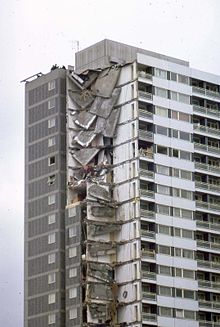Disproportionate collapse
Contents |
[edit] Introduction
 Disproportionate collapse (or progressive collapse) occurs in a building when the failure of one component leads to the progressive failure of a series of other components, often with catastrophic results. The effect is very similar to that seen in a game of Jenga, pictured.
Disproportionate collapse (or progressive collapse) occurs in a building when the failure of one component leads to the progressive failure of a series of other components, often with catastrophic results. The effect is very similar to that seen in a game of Jenga, pictured.
[edit] Ronan Point
A well-known example occurred in Newham, East London in May 1968 at a new 22-storey block of flats called Ronan Point. The reinforced concrete building featured prefabricated external wall panels. Unfortunately, a gas explosion resulted in the progressive collapse of an entire corner of the tower block, which killed four people and injured 17 other residents. The cause of the explosion was a resident striking a match to boil water which ignited the gas that was leaking from a joint in a newly-installed cooker.
The explosion blew out the load-bearing flank walls, which had been supporting the four flats directly above, lifting the ceiling and floor slab. This resulted in a house-of-cards progressive collapse as the floors above became unsupported. For further details see Ronan point.
Progressive collapse can be exploited deliberately as a demolition method to ensure a relatively quick and economic collapse if it is known the construction will respond appropriately.
[edit] Building regulations
Requirement A3 of the Building Regulations 2010 states:
‘The building shall be constructed so that in the event of an accident the building will not suffer collapse to an extent disproportionate to the cause.’
In other words, had Ronan Point been constructed in line with requirement A3, the damage would have been restricted to the floor where the explosion took place. Reducing a building’s tendency to disproportionate collapse can be met by a range of constructions set out in Approved Document B of the Building Regulations.
[edit] Pancake collapse
In the US, the term ‘pancake collapse' is sometimes used to describe the phenomenon of progressive collapse. The term was first used to describe a structural failure in the Bronx, New York, in August 1980, where a fire had weakened a structure to the extent that the floors fell successively in on one another, i.e they ‘pancaked’ down.
A similar effect was seen at the destruction of the twin towers of the World Trade Center, New York in September 2001. The fire produced by the aircraft strikes resulted in the progressive failure of the floor system; although initiated by the attacks, this was later deduced to be the primary mode of structural failure in the steel frame buildings. A number of code changes were initiated as a result of the investigation, one of which was to increase by one hour the fire resistance of structural components.
The Institution of Structural Engineers (IStructE) has published a two-volume guide to structural robustness and disproportionate collapse in buildings:
- Practical guide to structural robustness and disproportionate collapse in buildings.
- Manual for the systematic risk assessment of high-risk structures against disproportionate collapse.
[edit] Related articles on Designing Buildings Wiki
- Adam Curtis - The Great British Housing Disaster.
- Approved Document A.
- British post-war mass housing.
- Creep
- De la Concorde overpass collapse.
- Defects in construction.
- Grenfell Tower fire.
- Modular buildings.
- Offsite manufacturing.
- Prefab bungalows.
- Prefabrication.
- Ronan Point.
- Structural failures.
- The structural condition of Easiform cavity-walled dwellings (BR 130).
[edit] External references
Featured articles and news
One of the most impressive Victorian architects. Book review.
RTPI leader to become new CIOB Chief Executive Officer
Dr Victoria Hills MRTPI, FICE to take over after Caroline Gumble’s departure.
Social and affordable housing, a long term plan for delivery
The “Delivering a Decade of Renewal for Social and Affordable Housing” strategy sets out future path.
A change to adoptive architecture
Effects of global weather warming on architectural detailing, material choice and human interaction.
The proposed publicly owned and backed subsidiary of Homes England, to facilitate new homes.
How big is the problem and what can we do to mitigate the effects?
Overheating guidance and tools for building designers
A number of cool guides to help with the heat.
The UK's Modern Industrial Strategy: A 10 year plan
Previous consultation criticism, current key elements and general support with some persisting reservations.
Building Safety Regulator reforms
New roles, new staff and a new fast track service pave the way for a single construction regulator.
Architectural Technologist CPDs and Communications
CIAT CPD… and how you can do it!
Cooling centres and cool spaces
Managing extreme heat in cities by directing the public to places for heat stress relief and water sources.
Winter gardens: A brief history and warm variations
Extending the season with glass in different forms and terms.
Restoring Great Yarmouth's Winter Gardens
Transforming one of the least sustainable constructions imaginable.
Construction Skills Mission Board launch sector drive
Newly formed government and industry collaboration set strategy for recruiting an additional 100,000 construction workers a year.
New Architects Code comes into effect in September 2025
ARB Architects Code of Conduct and Practice available with ongoing consultation regarding guidance.
Welsh Skills Body (Medr) launches ambitious plan
The new skills body brings together funding and regulation of tertiary education and research for the devolved nation.
Paul Gandy FCIOB announced as next CIOB President
Former Tilbury Douglas CEO takes helm.























